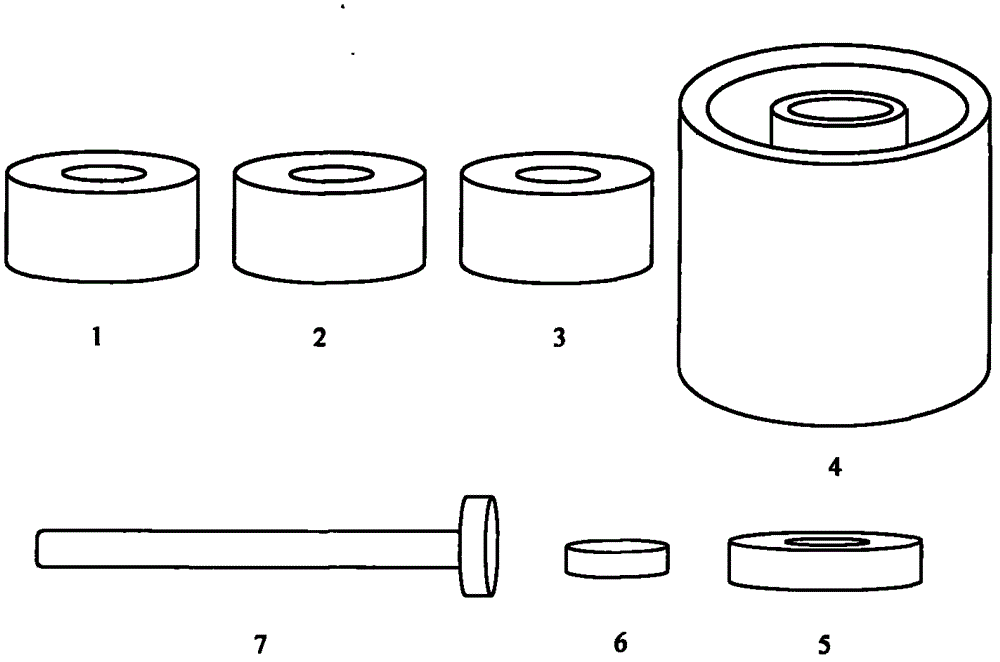Teaching instrument for demonstrating superconducting characteristic
An instrument and superconducting technology, applied in the field of experimental instruments capable of demonstrating Lenz's law and superconducting magnetic levitation phenomenon, achieving the effect of simple structure and easy operation
- Summary
- Abstract
- Description
- Claims
- Application Information
AI Technical Summary
Problems solved by technology
Method used
Image
Examples
Embodiment 1
[0019] Put the Dewar flat on the desktop, put the superconducting ring in the Dewar 4, the stainless steel ring 1, the aluminum ring 2, and the copper ring 3 respectively on the table, keeping the magnetic bar 7 away from the superconducting ring 5.
[0020] Add an appropriate amount of liquid nitrogen to the Dewar 4. To ensure safety, avoid liquid nitrogen splashing as much as possible. In the process of cooling the superconducting ring and Dewar with liquid nitrogen, violent boiling will occur due to a large amount of heat absorption. When the boiling basically stops, the superconducting ring drops to the same temperature as liquid nitrogen (minus 196°C), that is, it enters the superconducting state. At this point the preparations are ready and the experiment can begin.
[0021] Insert the magnetic bar 7 into the stainless steel ring 1, the aluminum ring 2 and the copper ring 3 at the same speed in turn, the operator can feel that the resistance of the magnetic bar 7 is obv...
Embodiment 2
[0044] Place the magnetic block pad on the desktop, place the magnetic block 6 on the top of the magnetic block pad, and then place the Dewar 4 on the desktop so that the magnetic block 6 pad is in the hole in the middle of the Dewar 4 . Put the superconducting ring 5 into the Dewar 4, and then pour liquid nitrogen into it for cooling. When the liquid nitrogen stops violently boiling, the superconducting ring 5 enters the superconducting state. Hold the Dewar 4 with both hands and leave the table. At this time, the magnetic block 6 is suspended in the center of the Dewar 4 and moves together with the Dewar 4 .
[0045] After putting the Dewar 4 back on the table, lift the zipper tied to the superconducting ring 5 by hand, so that the superconducting ring 5 is separated from the Dewar 4, and at this time the magnetic block 6 is lifted and suspended in the round hole of the superconducting ring 5 central. The magnet 6 is moved by hand, and the magnet block 6 can be suspended a...
PUM
| Property | Measurement | Unit |
|---|---|---|
| Line length | aaaaa | aaaaa |
| Length | aaaaa | aaaaa |
| Length | aaaaa | aaaaa |
Abstract
Description
Claims
Application Information
 Login to View More
Login to View More - R&D
- Intellectual Property
- Life Sciences
- Materials
- Tech Scout
- Unparalleled Data Quality
- Higher Quality Content
- 60% Fewer Hallucinations
Browse by: Latest US Patents, China's latest patents, Technical Efficacy Thesaurus, Application Domain, Technology Topic, Popular Technical Reports.
© 2025 PatSnap. All rights reserved.Legal|Privacy policy|Modern Slavery Act Transparency Statement|Sitemap|About US| Contact US: help@patsnap.com



